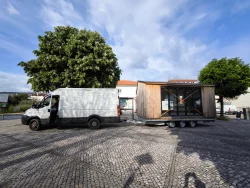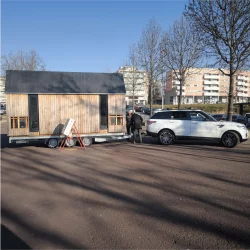
The KUKUmobil is a textile workshop on wheels, big enough to host a high warp loom, and small enough to traverse the European continent with agility.

What Is the KUKUmobil?
Is it a workshop on wheels? A mobile showcase for public spaces? A nomadic gallery? A travelling artist residence? The KUKUmobil is not any one of these, but contains a little bit of each. In this combination of elements lies its strength and unique perspective.
I work and live in it while I travel through Europe. It is the vantage point from which I observe the day to day at each stop, and in turn, anyone who walks by is welcome to come closer and observe what is happening inside. Through this coming together, the KUKUmobil livens up public squares, enriches the cultural landscape, and becomes a place of exchange for stories, experiences, knowledge and skill.
If you want to know more about how we made this peculiar space, you can read our builders’ diary.
The KUKUmobil aspires to:
- Shine a light on a craft that has evolved along with humankind for millenia. Each generation of weavers has refined and expanded it before passing it on to the next, yet now it is on the brink of extinction.
- Advocate for the preservation of our cultural heritage. The KUKUmobil presents this effort as a collective, rather than an individual one. It is a society’s responsibility to make its shared knowledge available to future generations.
- Reflect on the future of Europe and the fabric of our society. The tapestry will reflect the diversity of European experiences and identities; it will be a metaphor for their interwoven coexistence, and a commitment to a European project that is in service of its civil society.
- Invite a return to a human dimension of size, speed, perception, creativity, and complexity. The KUKUmobil aims to find a balance between our urge to envision and create at a constantly growing scale and pace, and the boundaries and self-awareness required for an equitable and resilient practice.
- Change our understanding of time, in the philosophical as well as the practical, haptic sense. Slow art and slow living can be a path that leads us back to the human dimension and to a meaningful, sustainable future.
- Bring knowledge transfer into the public space. The KUKUmobil reframes public space as a place of learning. It creates opportunities for experiencing community and identity in new ways, and makes knowledge transfer accessible and part of everyday life.
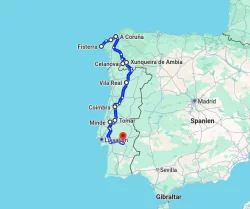
Where it's going
To get straight to the point, because it is fundamental to the project: there is no previous organised route, but rather a rough direction. The first stage of the journey began almost a year and a half ago on the coast of northern Spain and will take the KUKUmobil to southern Portugal, where it will meet the sea again. Then it will turn around and head north again. This zigzag course north_south_north_south is the basic rhythm of the journey. But where exactly it will travel is determined by the road network and your recommendations, contacts and the permits I receive for the stops. So, your ideas and your support are more than welcome.
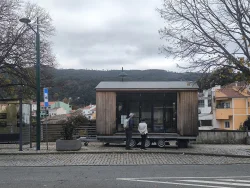
Where is the KUKUmobil now?
The KUKUmobil has found a new location, this time in the heart of the Serra de Monchique. Right next to THE bus stop, with the Jardim dos Chorões city park behind it and overlooking the Largo de 5 de outubro square, between the Sunday farmers' market and the Christmas market, the KUKUmobil will spend the last weeks of 2025, eagerly anticipating the coming year.
Rua Serpa Pinto, Monchique, Portugal
From November, 28th
in Google Maps.

Making it happen together
The KUKUmobil started its journey in early April 2024 in Fisterra (Galicia), and plans to cross the European continent until it reaches the Black Sea. Where and how often it will stop, how long it will take, and how far it will actually go, are unknowns that we will solve together over the coming months and years. This voyage is a collective one.
We are designing the route together:
- With your invitations and suggestions, and advocacy to the appropriate groups to obtain stay permits (municipal authorities, neighbourhood associations, or other local organizations).
- With your ideas and collaboration in matters of transportation.
- With your time and interest in participating in a workshop or visiting a pop-up exhibition.
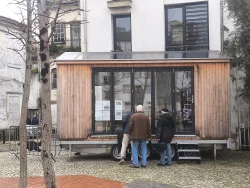
The KUKUmobil is looking for…
STOPS. While traveling through lands unknown (to me), I will consult with those who do know them to decide where to stop. If you want the KUKUmobil to visit your city or area, are willing to help organize one of the stops, or have contacts in the realms of arts and culture (or work in them yourself), get in touch!
The KUKUmobil is looking for…
TRANSPORT. I don’t drive, but I know that there are people out there who love driving as much as I love weaving. The KUKUmobil does not have its own vehicle, and instead searches for driving enthusiasts or transportation professionals when it is time to travel to the next stop. If you have a car that can pull a 3-ton trailer, or know someone who does, get in touch!
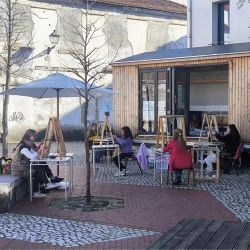
The KUKUmobil offers…
WORKSHOPS. I like sparking interest and planting the seeds for new passions to grow. With this goal in mind, I offer workshops that convey the fundamental principles of weaving and illustrate the process of creating a pictorial tapestry. If you want to take part in a workshop, get in touch!
EXHIBITIONS. Whenever the opportunity presents itself, I exhibit some of the large format pictorial tapestries that I have woven in the past, together with the small “sketch tapestries” that I am producing during this journey. The exhibitions are easy to set up and brief by nature, yet successfully showcase the complexity and beauty of the art form.
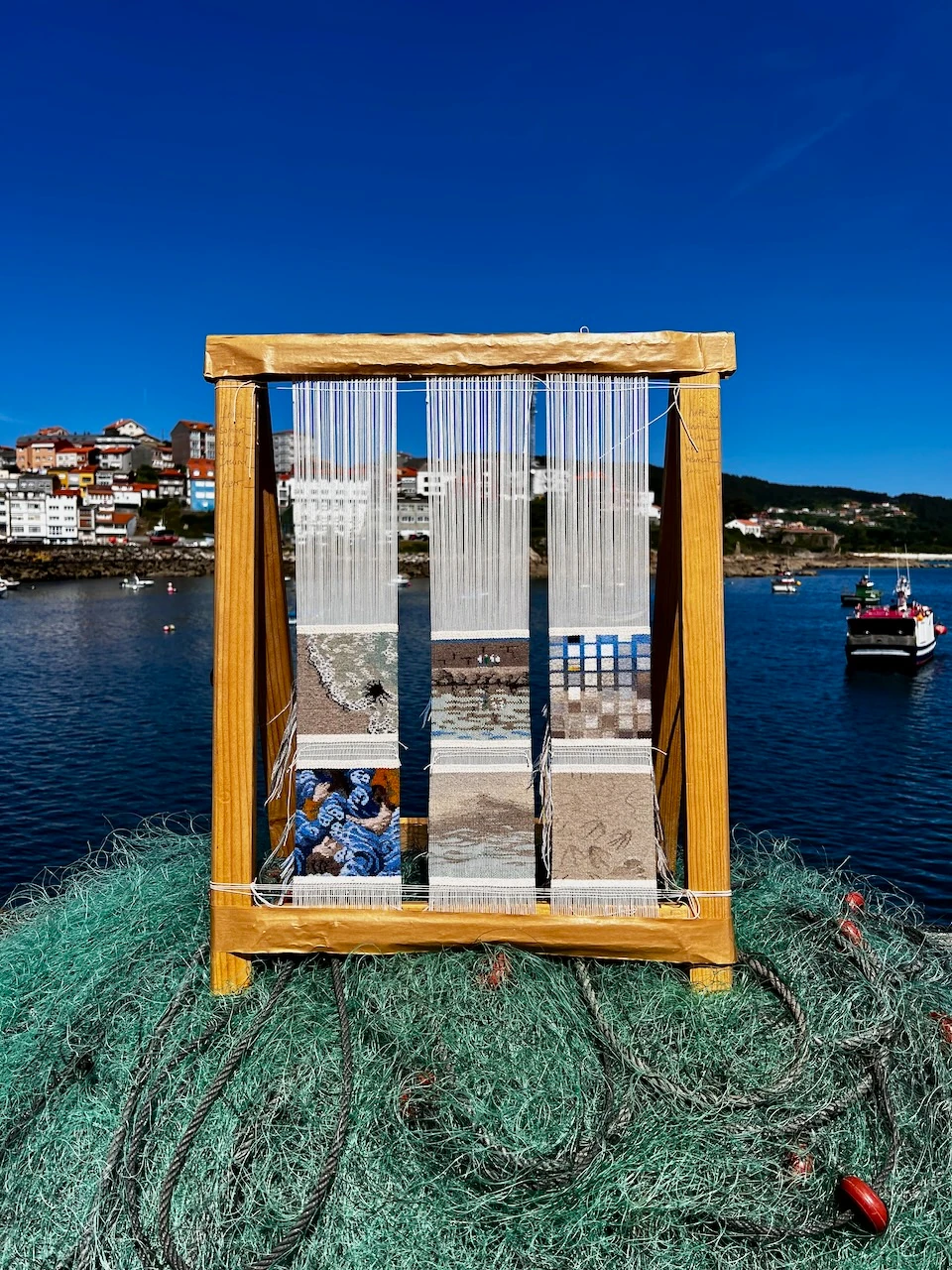
Do you want to take home a piece of the project?
The sketch tapestries are an essential step in the development of the concept for the large tapestry. They are also a good representation of the variety within the woven medium.
Each piece is unique and captures a place, moment, object or specific situation in a 12 x 12 cm pictorial tapestry. Some of the motives will later find their way into the big loom. They are an important component of the KUKUmobil project and its journey through Europe.
If you are interested in one of these sketch tapestries and wish to support the KUKUmobil, send me a message and mention the number of the piece that has caught your eye.
Each piece is unique and captures a place, moment, object or specific situation in a 12 x 12 cm pictorial tapestry. Some of the motives will later find their way into the big loom. They are an important component of the KUKUmobil project and its journey through Europe.
If you are interested in one of these sketch tapestries and wish to support the KUKUmobil, send me a message and mention the number of the piece that has caught your eye.
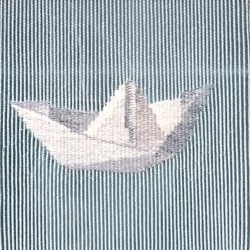
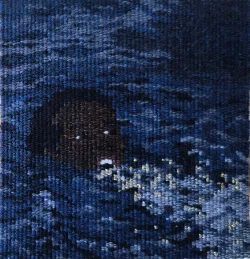


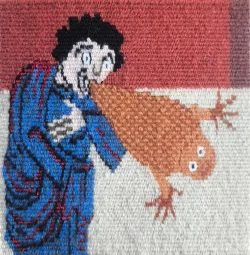


Why a loom?
My vision for Europe is that of a fair, socially minded cultural area for everyone, built on a long (if not always commendable) shared history and a sense of solidarity; an area that is home to diverse cultures, landscapes, peoples, languages, and ways of life.
I asked myself what I could contribute to this vision, and since I am a weaver, I had the idea of capturing it in a tapestry. Afterall, a tapestry is a good metaphor - threads can be woven into a cohesive and resilient fabric that celebrates the variety and richness of their colours, as long as it is done with care, minding the tension, closing the gaps… Each thread is important and purposeful, but only if they are carefully intertwined with each other rather than left hanging loose.
I asked myself what I could contribute to this vision, and since I am a weaver, I had the idea of capturing it in a tapestry. Afterall, a tapestry is a good metaphor - threads can be woven into a cohesive and resilient fabric that celebrates the variety and richness of their colours, as long as it is done with care, minding the tension, closing the gaps… Each thread is important and purposeful, but only if they are carefully intertwined with each other rather than left hanging loose.

How is a pictorial tapestry made?
The art form of weaving pictorial tapestries blends painting and weaving.
At the start is a painting or quick drawing, a watercolour or photograph, an abstract or figurative design, a landscape, an object… In short, an idea represented in pictorial terms with pictorial tools.
The second step is the development of the cartoon, a drawing of the same size as the eventual tapestry, where the initial image is broken up into colour fields. The cartoon can be coloured in, although it is often just a line drawing that might include numbers as a colour guide. The cartoon serves as a guide to the weaver, and is attached to the warp that is set up on the loom.
At the start is a painting or quick drawing, a watercolour or photograph, an abstract or figurative design, a landscape, an object… In short, an idea represented in pictorial terms with pictorial tools.
The second step is the development of the cartoon, a drawing of the same size as the eventual tapestry, where the initial image is broken up into colour fields. The cartoon can be coloured in, although it is often just a line drawing that might include numbers as a colour guide. The cartoon serves as a guide to the weaver, and is attached to the warp that is set up on the loom.

Now the weaving begins. The bobbins carry threads of different colours and colour mixtures - they are the weaver’s paint brushes. They weave in and out of the warp, introducing the weft, and letting it fill the fields laid out by the cartoon in the corresponding colours.
Large tapestries are rolled up on the loom as they grow. While work is ongoing, which may be for months or even years, only a small section of the piece is visible. The complete image can only be appreciated once the tapestry is taken off the loom (tombée de métier). It is a significant and emotional moment of revelation.
If you are curious to see some of the tapestries I have woven over the last decades, visit the gallery.

What is going to happen on the big loom?
The large high warp loom is the centrepiece of the KUKUmobil, my work tool and my travelling companion. It is the first time that I start a tapestry without finishing the design first. There is a good reason for that: if I already knew what was to be woven, there would be no reason to travel.
This time around, I am developing the concept for the tapestry as I travel, and designing it in parts. At each stop I explore the surroundings, get inspired by its landscape and people, draw and take pictures. From this material, I choose a handful of motifs that I find interesting and weave them into small textile sketches.
I am searching for that which, to me, best represents each place or region. Once I have decided what that is, I prepare the respective section of the cartoon, set it up behind the big loom, and weave that part of the tapestry. That is how the pictorial tapestry will grow as the KUKUmobil traverses Europe’s cultural landscape.
If you want to see what sparks my curiosity, my explorations and the encounters I experience on my journey, take a peek at the travel journal.
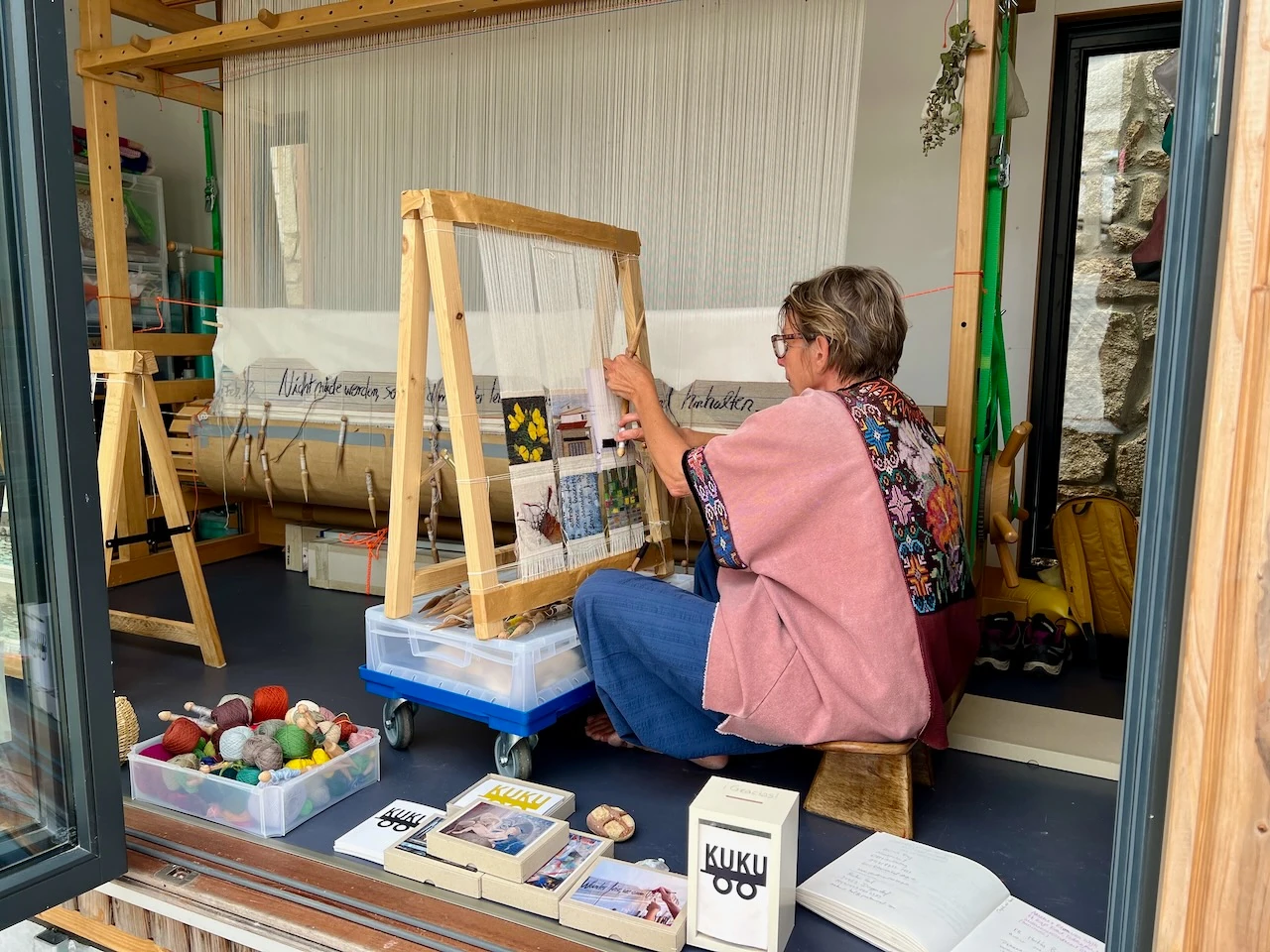
When we engage in fiber arts, we are creating something, but we’re also participating in historic traditions tens of thousands of years old.
You are not only making art for your soul and for future generations, you are embodying the work of our ancestors.
Meadow Coldon, The Woven Road
You are not only making art for your soul and for future generations, you are embodying the work of our ancestors.
Meadow Coldon, The Woven Road
The KUKUmobil is a tracker of our artistic and artisanal past; a collector of textile, cultural, and geopolitical identities; a nomadic chronicler of this time of upheaval; a knowledge-keeper and creator of ideas in equal parts. Ultimately, it will be an “instigator” of new connections and a catalyst of a European spirit and identity that is already alive in many hearts and minds.
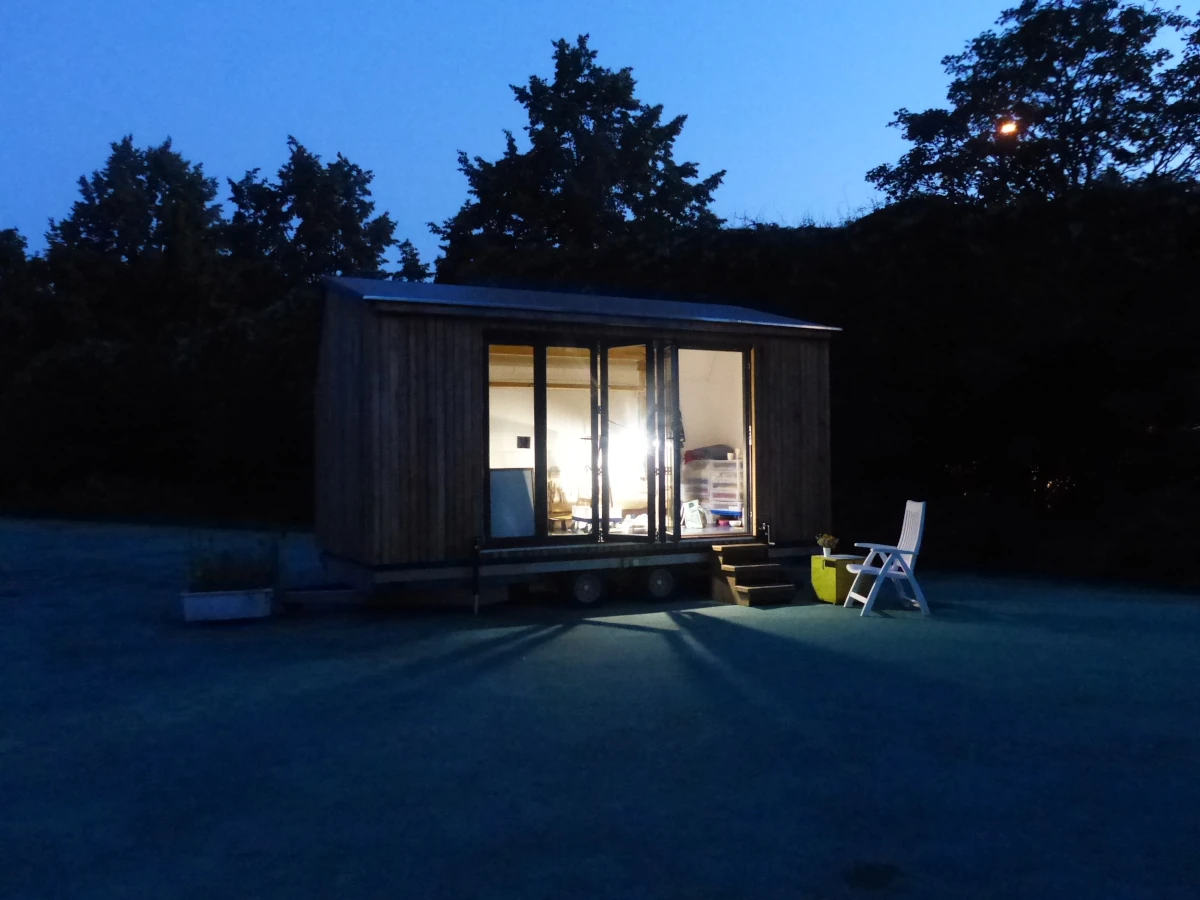
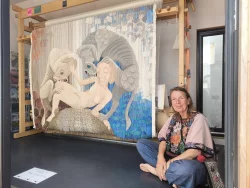
The Weaver
My name is Andrea Milde; I was born in Germany, where my parents immigrated to from further East in Europe. I have always been a nomad at heart, and yet my connection to my European identity has only gotten stronger over time.
Weaving pictorial tapestries is my life. It allows me to combine two great passions of mine: painting and working with colourful threads.
I trained as a tapestry weaver in France four decades ago.
The years of exploring and learning, the experiences and knowledge acquired, have filled a backpack of content that I like to shake out and share with others.
I trained as a tapestry weaver in France four decades ago.
The years of exploring and learning, the experiences and knowledge acquired, have filled a backpack of content that I like to shake out and share with others.
Find my full CV here.
The KUKUmobil community grows with each stop
There are quite a few of you who have already come across the KUKUmobil during its construction in 2022, on one of its “test drives” in 2023, and since the beginning of its current journey in April 2024.
The KUKUmobil community is anyone who follows the travel journal, hoping that their hometown is on the route; has facilitated a stop or has offered to do so when the time comes; has transported it or supported it financially; has stopped by for a lovely chat and a selfie, a workshop, or to visit a pop-up exhibition; has told others of the KUKUmobil and its journey; has brought me a piece of fishing line, a sandwich, a glass of wine, some nice rocks or a sea shell; has taken me on an expedition or told me stories of the past and present...
I hope that this community continues to grow, and that we all meet one day, somewhere in Europe, in front of a large finished tapestry.
The KUKUmobil community is anyone who follows the travel journal, hoping that their hometown is on the route; has facilitated a stop or has offered to do so when the time comes; has transported it or supported it financially; has stopped by for a lovely chat and a selfie, a workshop, or to visit a pop-up exhibition; has told others of the KUKUmobil and its journey; has brought me a piece of fishing line, a sandwich, a glass of wine, some nice rocks or a sea shell; has taken me on an expedition or told me stories of the past and present...
I hope that this community continues to grow, and that we all meet one day, somewhere in Europe, in front of a large finished tapestry.


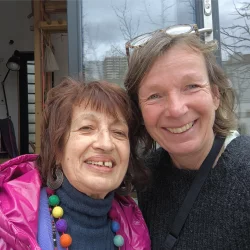
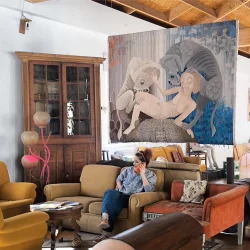



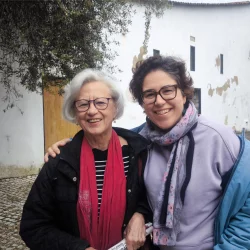
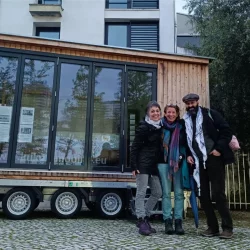

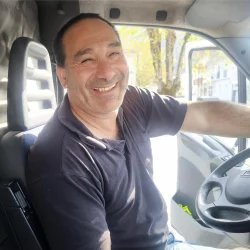
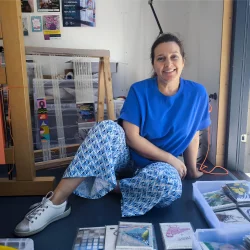
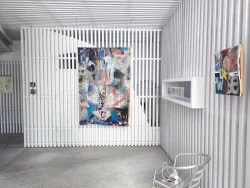
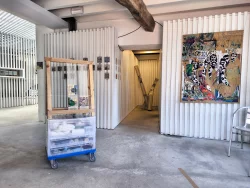
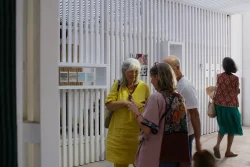
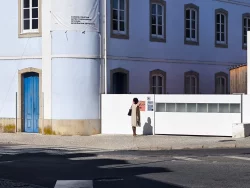

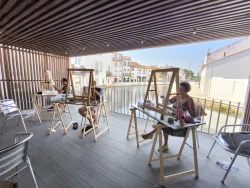
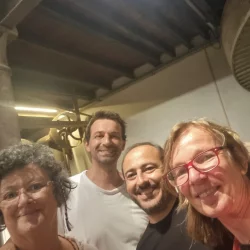
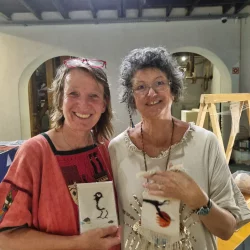
Contact
I would love to hear from you! This website is meant not only as a showcase for my work, but also as a forum to exchange ideas, impressions, thoughts…

